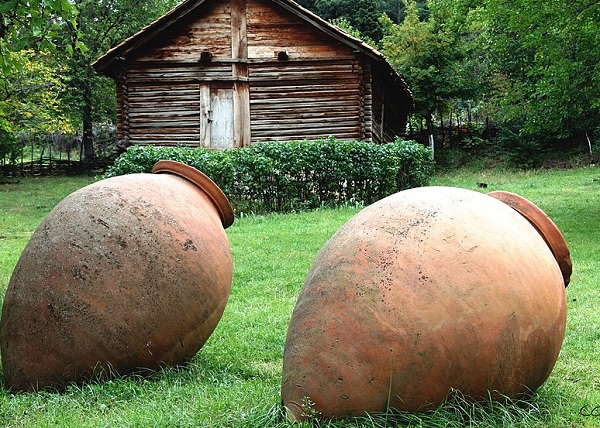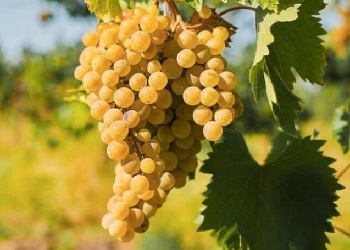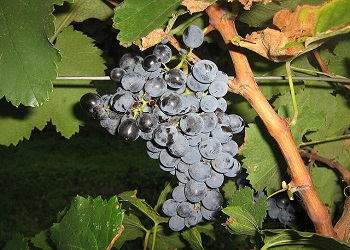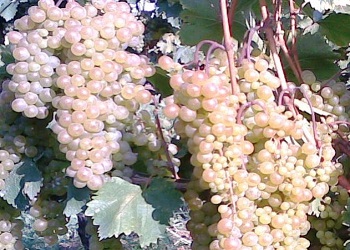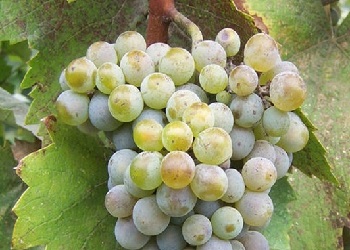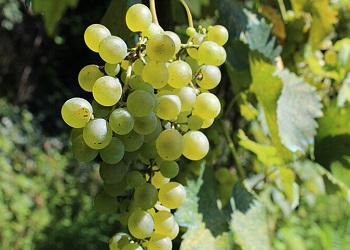Georgian Wine
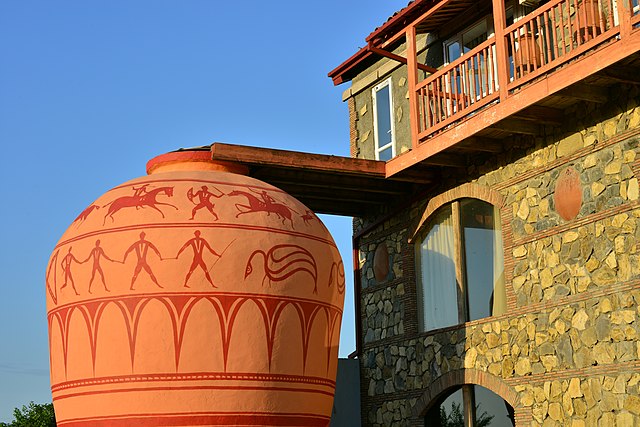
Decorative Kvevri of Twins Old Cellar Wine house in Napareuli
During the Soviet period, Georgia was the biggest wine producer of the the Soviet Union.
After 1985, when Mikhail Gorbachev started an anti-alcohol campaign which raised the price of wine and restrictet the sale, many large georgian wine factories was closed.
After beeing independent in 1991, many small-scale producers have done a fantastic jobb to raise the quality of Georgian wine.
Grapes
The Cradle of Wine
in November 2017, south of the Georgian capital Tbilisi, 8000 years old clay jars containing residual wine compounds were found.
The jars had images of grape clusters and men dancing.
This is (so far) the world's earliest evidence of grape wine-making.
Red Wines |
White Wines |
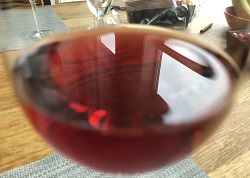
|

|
Qvevri Wines |
Sparkling Wines |

Mtsvane Qvevri |

|
Off-dry and Medium Sweet Wines
Georgia is also famous for its sweeter wines, made from grapes picked later than usual, when sugar levels are at its highest.
Sweetness balanced by acidity works wonders when paired with spicy food. The most famous off-dry (or sweet) wines include Pirosmani and Alazani.
Kvevri Wines
The process of making wine in a Kvevri (Qvevri in Eglish) is a deep Georgian tradition.
It is a method and a ritual of strong cultural significance, closely tied to family traditions, and religious celebrations.
Many Georgian families produce their own kvevri wine for household use.
White Kvevri wines are golden in color, tannic like red wines, with complex aromas like dried fruit, herbs, tea, nuts.
Red Kvevri wines are earthy, structured, and deeply expressive of terroir. Often cloudly and unfiltered.
In Georgia, skin-contact white wine is known as "karvisperi ghvino", which translates as amber wine. This term was introduced by Sandro Shanshiashvili in his 1920 poem "Wine".
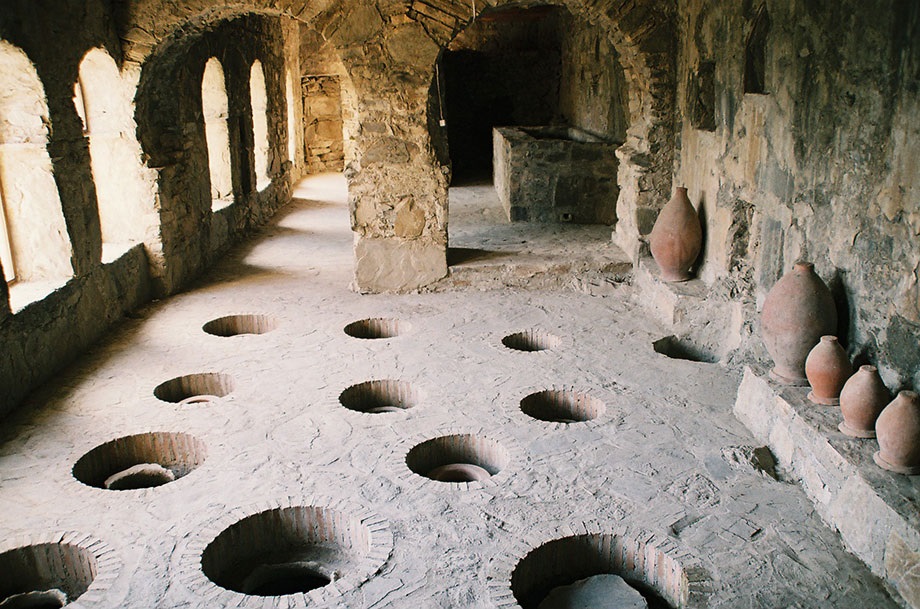
Kvevri winemaking dates back over 8,000 years and is unique in its use of large terracotta vessels buried underground.
Image credit: National Wine Agency, Georgia.
Kevri Winemaking
In 2013, UNESCO added this ancient Georgian winemaking method to the UNESCO Intangible Cultural Heritage List.
Below is a description of the Kevri winemaking process, as it is recognized by UNESCO:
Grape Harvesting
The grapes are picked by hand to preserve quality and avoid damaging the skins.
Indigenous Georgian grape varieties are used (Rkatsiteli, Saperavi, Mtsvane).
Crushing and Pressing
Traditionally, the grapes are crushed by foot or by a wooden press (satsnakheli).
The entire contents (juice, skins, seeds, stems) are transferred into the Kvevri.
The large egg-shaped Kevri (500–3500 liters) is buried in the ground to maintain a stable, cool temperature.
Fermentation
Unlike modern winemaking, no sulfites or commercial yeasts are added.
The fermentation starts naturally within a few days, due to wild yeast present on the grape skins.
It lasts for 1 to 3 weeks, during which:
- The cap (skins and solids) rises to the top.
- The winemaker manually punches down the cap a few times a day to ensure good extraction and even fermentation.
- No temperature control is used. The temperature is regulated by the soil temperature.
Maceration and Aging
After fermentation, the kvevri is sealed with a wooden or stone lid, sometimes reinforced with clay or beeswax to make it airtight.
A layer of oil or a clay lid covered with wet sand may also be used to protect the wine.
After fermentation, the wine is left in contact with the skins, stems, and seeds in the kvevri for an extended maceration period.
White wines (known as amber wines) can stay on the skins for 5–6 months, gaining tannins, structure, and deep color.
Red wines usually macerate for a shorter period (about 1 month). The solids eventually settle at the bottom, and the wine clarifies naturally.
Racking and Bottling
In early spring, the wine is carefully racked (siphoned) from the kvevri into clean vessels, leaving behind sediment.
Sometimes, it’s aged further in another kvevri or bottled directly.
The remaining solids (chacha) can be used to make chacha, a Georgian pomace brandy.
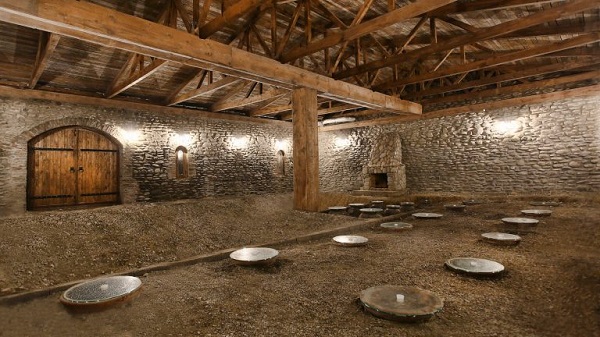
Kapistoni Wines produces natural wines in kvevri.
Photo courtesy of Kapistoni Wines.
Cleaning the Kvevri
Once emptied, the kvevri must be thoroughly cleaned:
- Scrubbed with special tools like cherry bark brushes.
- Rinsed with hot water and sometimes lime or ash water to disinfect.
- The inside may be lined with a thin coat of beeswax, though this depends on regional custom.
- Scrubbed with special tools like cherry bark brushes.
- Rinsed with hot water and sometimes lime or ash water to disinfect.
- The inside may be lined with a thin coat of beeswax, though this depends on regional custom.
